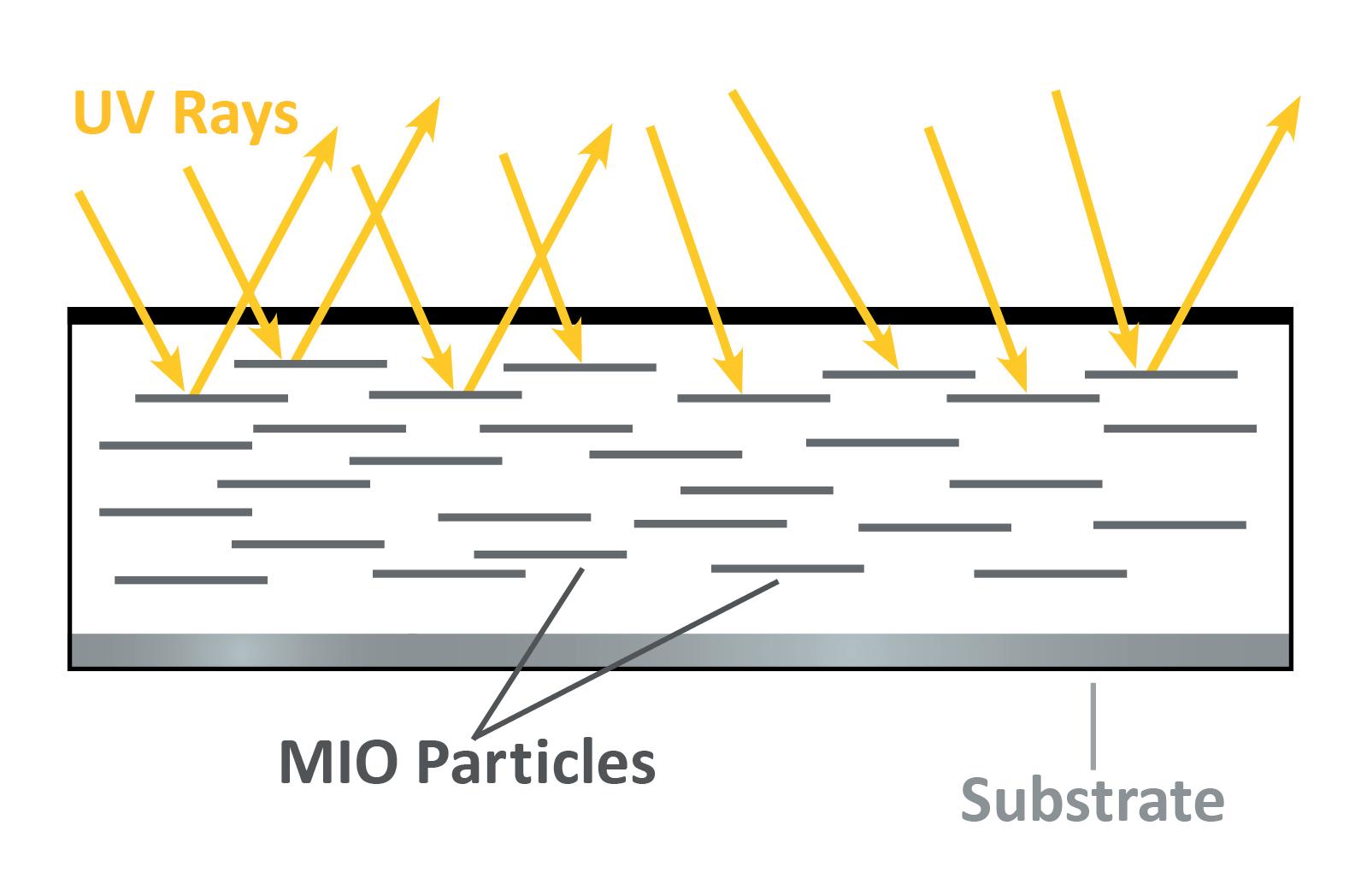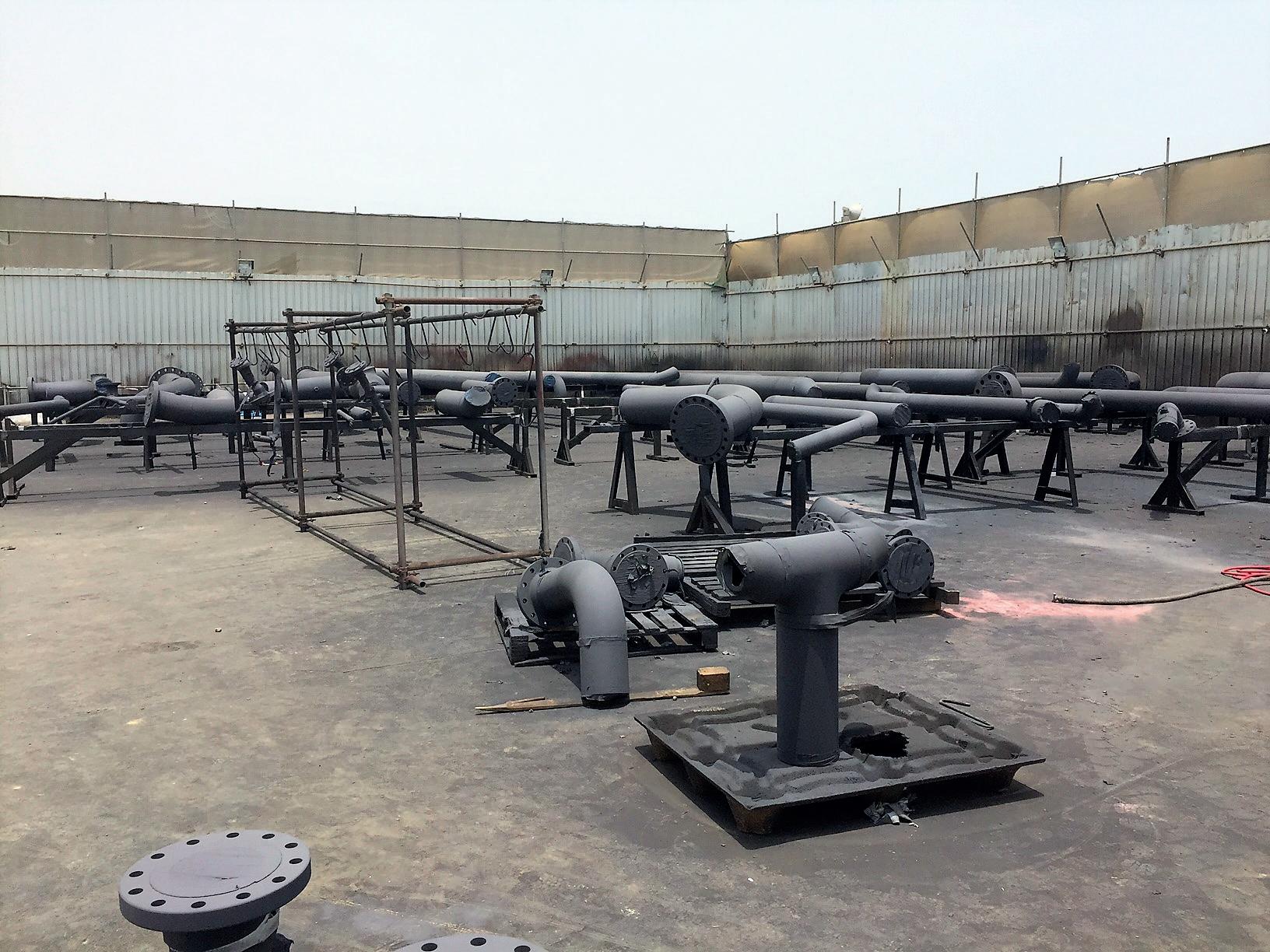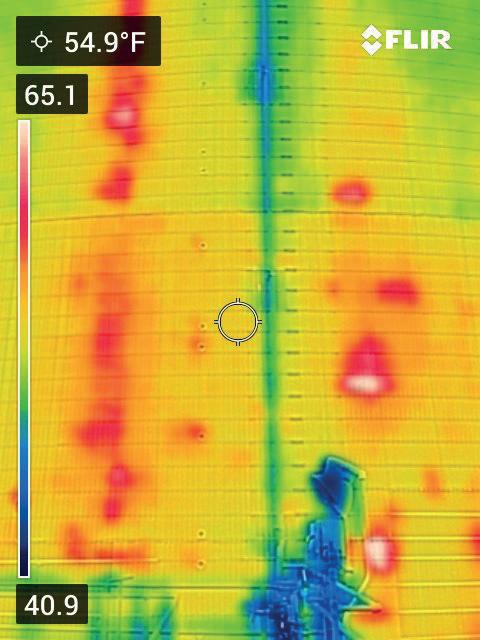
12 minute read
Answer to the corrosion conundrum?
Bruce Toews (USA), Neil Wilds (UK), and Johnny C. Pourciau (USA), Sherwin-Williams Protective & Marine, look at how coating additives can enhance corrosion protection before and during service.
Protective coatings applied beneath insulation on pipes, valves, tanks, and other downstream assets used in LNG operations are important tools in mitigating the troublesome and potentially dangerous phenomenon of corrosion under insulation (CUI) (Figure 1). However, most coatings are not up to the task – especially those without sufficient film builds and reinforced additives – and are prone to premature deterioration under insulation. The problem comes when moisture mixed with contaminants penetrates and then saturates the insulation. Trapped inside and subject to elevated temperatures, the water and contaminants can initiate the development of corrosion cells that eat away at coatings, thus threatening the covered asset. CUI can be especially prevalent in the bends, flanges, and elbows of insulated pipework transporting LNG byproducts, the undersides of pressure vessels within LNG process trains, and the lower areas of ground LNG storage tanks – all areas where moisture collects due to gravity.
To make matters worse, certain epoxy-based linings can start deteriorating even before insulation is installed over the top of them, as freshly coated assets shipped to LNG and petrochemical plants throughout the world may face lengthy delays before they are installed. The journey can take up to a year or longer, and during that time, ultraviolet (UV) rays from the sun and corrosive chlorides from seawater can degrade the epoxy coatings, even if they contain anti-corrosive ingredients.
Understandably, it would seem that CUI is inevitable in LNG operations. That is why the historical focus has been to mitigate CUI for as long as possible. The industry is always
looking for a better way to do so, and four types of coatings have recently risen above the rest in terms of CUI mitigation in laboratory tests and real-world performance. They are high-temperature epoxy phenolics, high-temperature epoxies, ultra-high solids novolac amine epoxies, and inert multipolymeric matrix (IMM) coatings. Each has a common ingredient – micaceous iron oxide (MIO) – that creates an interlocked shield of overlapping plates, providing a hard but flexible level of protection in service and during transport.
Incredibly, however, a new coating now being tested may eliminate CUI, and insulation itself, entirely in some applications.
The spray-on, high-build coating would provide all the insulation needed to retain a sufficient amount of heat inside LNG storage tanks and other coated assets to enable continued operations while also protecting personnel from getting burned due to incidental contact with coated assets. Without traditional, bulky insulation covering a pipe, valve or vessel, there is no possibility CUI will be a factor on those LNG assets because nothing would cover the coating – there would be no insulation under which corrosion could form. Poised to hit the market in 2022, that solution may shake up both the coatings and insulation industries.

Figure 1. CUI is inevitable over time as moisture and contaminants get trapped under insulation on LNG pipes, storage tanks, and process vessels and face thermal cycling.
Figure 2. MIO pigments embedded in a coating form a barrier that deflects UV rays to minimise degradation of the coating. The layered pigment structure also mitigates the penetration of moisture, oxygen, and other elements into the coating.

Micaceous iron oxide fights CUI
The coatings industry is finding that certain linings that are effective in immersion environments also work best in mitigating CUI, since CUI occurs in immersion-like conditions. Such coatings contain flakes of natural MIO pigment. Lab experiments have shown that MIO flakes form a layered barrier that deflects UV rays to minimise degradation of the coating (Figure 2). This layering also mitigates the penetration of moisture, oxygen, and other elements into the coating, while increasing the coating’s durability against impacts and chemicals. In addition, MIO flakes withstand high temperatures until reaching their melting point of 1500˚C. That is important because insulated assets are often exposed to extreme heat.
Because they provide long-term protection, coatings containing MIO flakes traditionally have been popular on tanks holding hydrocarbon materials, offshore drilling platforms, and iconic structures such as the Eiffel Tower in Paris, France. However, MIO coatings have not been historically viewed as a solution for CUI in LNG and other operations. Therefore, such coating formulations have been lab-tested over the last two years to see if they could serve that function. The trials have included: � Accelerated CUI simulation testing conducted by an industrywide Joint Industry Practice (JIP). � International Organization for Standardization (ISO) 19277:2018 qualification testing, using the optional
Houston Pipe Test, which artificially aged and heat conditioned samples. Three CUI temperature categories were established, ranging from -45˚C to 204˚C (-49˚F to 400˚F), for topside and aboveground service. � Cryogenic tests that watched for blistering and cracking after temperature cycling from -196˚C (-320˚F) to 200˚C (392˚F). Although CUI occurs at ambient and higher temperatures, it can also strike in extremely cold conditions as condensation forms under insulation.
Blistering and cracking can take place with extreme temperature swings. � Dry film thickness (DFT) tolerance tests that studied how well coatings applied at various thicknesses resist cracking when exposed to thermal cycling under insulation. Coated steel panels were heated and allowed to cool slowly, exposed to a temperature of 200˚C for eight hours, then cooled to ambient temperatures for 16 hours for five cycles.
An added benefit MIO additives offer relates to reducing volatile organic compound (VOC) emissions during application. The high-volume solids coatings release few emissions upon curing, making the workplace and environment safer and cutting VOC permitting expenses.
Test results: high-temperature epoxy phenolics
High-temperature epoxy phenolics have experienced some well-publicised failures but showed promise in the lab as CUI mitigators. The coating tested was a two-component, amine-cured lining with good resistance to chemicals and
hydrocarbons. The coating showed no signs of cracking in the ISO 19277 test until the temperature approached 179˚C (350˚F). At 200˚C, the coating began to rust. In the cryogenic test, two coats totalling 8 - 10 mils of DFT did not deteriorate after exposure to five hot-cold temperature cycles. Finally, in DFT tests, coatings applied at both 9 - 10 mils DFT and 20 - 31 mils DFT cracked in welded areas after the temperature cooled from 200˚C. Thus, the maximum rating for this coating was 205˚C.
Test results: high-temperature epoxies
High-temperature epoxies performed even better in the lab than high-temperature epoxy phenolics over a similar operating temperature range. One MIO-filled hightemperature epoxy based on flake-filled advanced alkylated amide technology resisted CUI in temperatures ranging from cryogenic levels to 200˚C and showed strong stability in cryogenic thermal cycling testing with no cracking, flaking, or disbondment when applied in two 5 mil DFT coats. In ISO 19277 tests, the coating did not crack, flake, or rust before reaching 220˚C (428˚F). During DFT tests, the coating stayed intact up to 19 mils. It also yellowed less than the epoxy phenolic.
Due to their higher volume of solids, thicker film builds, and high edge retention, ultra-high solids novolac amine epoxies offer another step up in performance. The particular coating tested for CUI, with its strong chemical resistance and durability, was originally engineered for immersion service inside ballast, oil, and refined fuel tanks. Its volume solids is approximately 95%, which is markedly higher than the 60% - 70% volume solids in typical epoxy phenolics. In ISO 19277 and cryogenic tests, the coating experienced no deterioration up to 200˚C. Further, in DFT tests, the coating did not crack in any of the thicknesses applied, even above 30 mils. The coating did yellow heavily, but that did not affect its cracking resistance.
Inert multipolymeric matrix IMM coatings are ideal for insulated pipes, valves, and process vessels housing LNG byproducts and operating at extremely high temperatures where thermal shock can occur (Figure 3). The IMM material that underwent tests was designed to handle temperatures ranging from cryogenic levels to 649˚C (1200˚F). It is the hardest silicone coating in the petrochemical industry, but it also expands and contracts, like the asset underneath, so it can survive thermal fluctuations. Comparatively, epoxy coatings may turn brittle and crack from thermal shock.
In the JIP tests, the IMM coating met the most stringent pass criteria for oil and gas atmospheric systems and resisting stress corrosion cracking. In ISO 19277 testing, it surpassed the other three coatings tested, with no cracking, flaking, or rusting up to 265˚C (509˚F), which is close to the test’s maximum temperature. The coating held up after five hot-cold cycles in cryogenic tests and showed no signs of cracking in the DFT test, even when the thickness reached 24 mils.
A revolution against CUI
Someday, and perhaps sooner than later, even these four highperformance coatings might no longer be necessary to combat CUI on LNG assets. A new coating now undergoing trials has the potential to eliminate CUI altogether by acting as its own insulation, thus making traditional insulation obsolete. With the ‘I’ in CUI gone, the ‘U’ would also disappear, as the ‘C’ could

Figure 3. Applying IMM coatings embedded with MIO to process vessels, pipes, and valves in LNG operations can effectively protect those assets from damage and corrosion prior to service, as well as mitigate the effects of CUI when assets are later insulated and placed into service.
Figure 4. Forward looking infrared (FLIR) imaging inspections of this ground storage tank reveal areas of concern for CUI, with the red areas indicating areas of excessive heat loss.

no longer develop under anything in the system. Atmospheric corrosion would be the only type of ‘C’ possible.
With traditional insulation such as mineral wool, a corrosion zone exists between the insulation and the asset’s coating. Moisture mixed with contaminants frequently enters this area through small gaps in the insulation system’s cladding. The moisture and contaminants become trapped in the corrosion zone and face thermal cycling, eventually causing CUI. In recent field testing, insulation stripped from storage tanks contained between 17% and 70% water. When moisture content in insulation exceeds 10%, thermal performance significantly deteriorates, requiring operators to use more heat to insulate the asset. That heat is needed, for example, to bring sulfur recovery units up to temperature in LNG process trains if system contents have lost heat following gas sweetening. If saturated insulation is not performing, operators will need to pump more heat into the recovery units, thereby increasing the plant’s energy consumption, while also contributing to the increased likelihood of CUI developing in the warm, moist environment.
Inspections have always been necessary to detect CUI. Radiography and ultrasound can help spot corroded areas without physically disturbing the insulation. Another option is drilling holes in the insulation system, but creating and filling such holes creates weak points in the system where moisture can enter. The most costly and time-consuming inspection method is to completely remove the insulation, which is reserved for when corrosion is highly visible on the exterior of the insulation such as underneath an LNG process vessel or pipe. When using the coating that is now under development, corrosion inspections would be inexpensive and easy, requiring only a walk past the asset since its surfaces would not be hidden by traditional insulation.
The new coating is based on existing products that have already battled CUI, but it is far superior. The coating is applied much thicker than any other now on the market, up to 10 mm DFT in two coats, plus a topcoat to seal and smooth the finish. At that thickness, the coating retains heat similarly to traditional insulation, as proven in forward looking infrared (FLIR) imaging taken on a ground storage tank being tested with the coating. The coating creates a monolithic barrier that bonds to the surface of the asset, leaving no gap or corrosion zone for moisture to get close to the substrate. Further, the coating’s thermal performance will not reduce over time unlike when traditional insulation becomes laden with moisture.

Figure 5. A new insulative coating (shown here without a topcoat) poised to launch in 2022 is applied up to 10 mm DFT in two coats to retain sufficient heat in pipes and vessels, like this ground storage tank, such that traditional insulation systems are not needed.
Figure 6. FLIR imaging of this ground storage tank being covered with a new insulative coating demonstrates how well the coated areas (blue and green) retain heat compared to the non-coated areas (red and yellow).

A few limitations
The new coating does come with limitations. Applying 10 mm DFT coats is a slower process compared to other thinner-build systems and requires a different type of pump. However, the application is much faster than installing traditional insulation, with its pins, clips, and weather shields. Applying two coats of the new product takes three days. Also, the coating requires longer drying times, especially in humid environments. In addition, the new coating’s maximum temperature exposure is 190˚C (375˚F) with excursions to 205˚C (400˚F), which means it can handle a wide variety of systems and environments but not all. The goal for the future is to reach an even higher temperature range.
Cost is another factor. The new coating is more expensive than traditional insulation such as mineral wool, but it will pay off over the long-term. For example, modelling software from the North American Insulation Manufacturers Association (NAIMA) gives 2 in. mineral wool a thermal efficiency rating of 93%. But this figure does not consider moisture that eventually seeps into the insulation and which quickly decreases the thermal efficiency rating down to 60%. In comparison, the new coating’s thermal efficiency rating is 73% - 78% when applied to specifications, and that never changes.
A hopeful future
For years industry professionals have been searching for the best ways to limit or even eliminate CUI. With four types of coatings containing MIO performing impressively at mitigating CUI in the lab, users should take note of how they end up performing in the field. Meanwhile, in 2022, a new solution may revolutionise the coatings industry and possibly bring an end to CUI in most applications.










